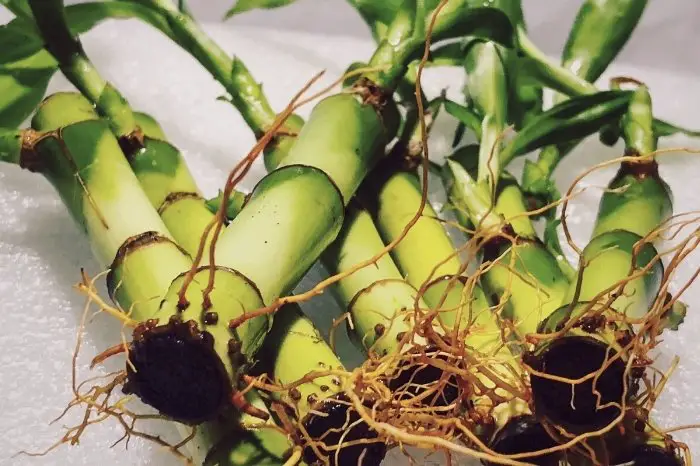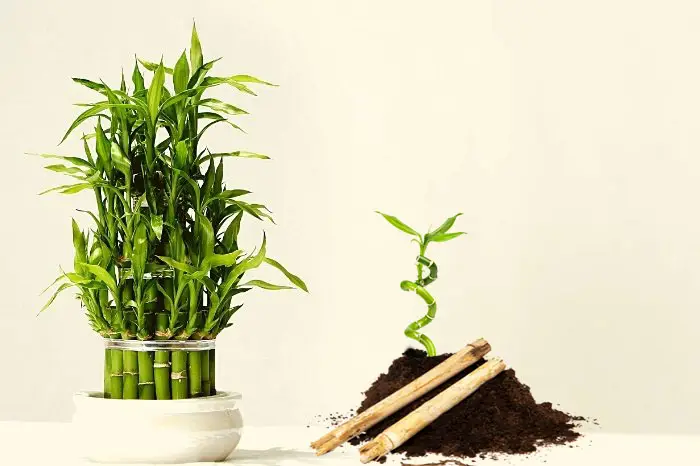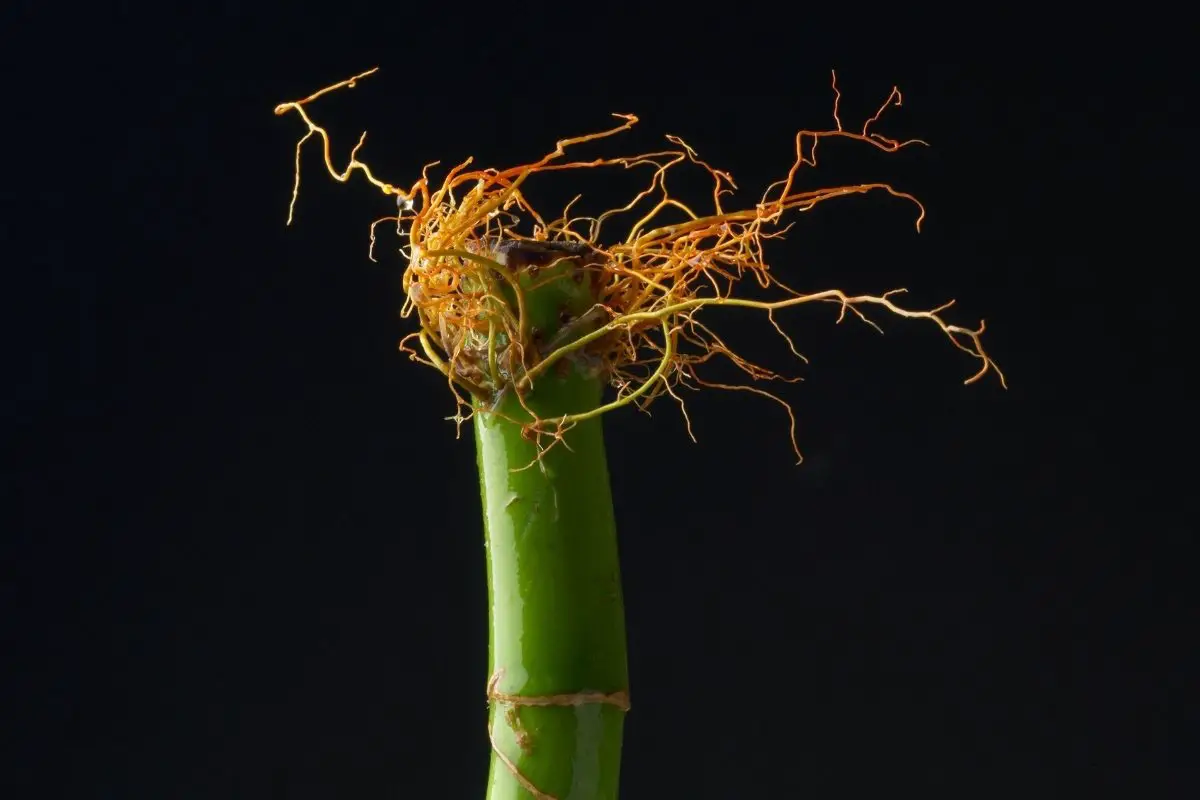Last Updated on March 16, 2023 by Cristina
Lucky bamboo root rot is a common problem that these popular houseplants face in their growth journey.
Lucky bamboo is a popular houseplant that is not a real bamboo. It has beautiful leaves and stems and tolerates neglect. Lucky bamboo typically comes in a vase-like container with its roots growing in water. It produces new shoots, which grow out of the top of the plant, and sometimes small white flowers that produce seeds.
What Does Lucky Bamboo Root Rot Look Like?
Lucky bamboo is trendy! They are known to bring good fortune, but these plants have their problems too. Lucky Bamboo commonly develops a condition known as lucky bamboo root rot. This happens if the potting soil they grow in becomes too damp.
A plant with lucky bamboo root rot will show symptoms of wilting leaves, lesions or browning on the leaves that spread towards the stem, and moldy growing tips. The stems will become mushy and slimy with time. When experiencing root rot, the lucky bamboo plant will not be able to absorb nutrients properly, making the leaves turn yellow and fall off.

If left untreated, these potted plants can die within weeks due to growth stunting & lack of new growth emerging from the base of older stalks. As the plant continues to die, the plant’s new shoots may also wilt or curve upwards.
Read more about What Do The Orange Root Plants Mean?
What Causes Root Rot In Lucky Bamboo
Lucky bamboo root rot occurs when you overwater your lucky bamboo houseplant. Overwatering leads to overly moist conditions in the soil, which provides the perfect environment for fungal spores to germinate and infect your bamboo plant roots through their simple pores.
Lucky Bamboo receives ample watering once every one or two weeks; however, allowing them to sit in stagnant water for a prolonged period will encourage root rot. Lucky bamboo enjoys room temperature water – not too cold or too hot. The root rot can set in within a few days if your plant sits in cold or hot water as this disrupts the balance between soil and roots.
If we imagine normal well-drained soil, you water the soil, the soil displaces air from the soil, and then as the water drains through and is absorbed by the plant, the air is pulled back into the soil. If soil is wet and does not drain, the oxygen levels in the soil will drop, and this then makes the soil unattractive to the plant roots and they die and rot. You drown your plant.
Learn more about Aloe Vera Stem: What It Is And How To Root It?
How To Deal With Lucky Bamboo Plant Rot
So how do you fix root rot in lucky bamboo? To ensure that your plant does not suffer from this common lucky bamboo root rot condition or to save it if it’s already showing signs of root rot, there are certain steps you need to take.
Stop overwatering your plant
Overwatering is the main reason for the lucky bamboo root rot. It should be watered once or twice a week with room temperature water. Leave it in the same container as long as possible without allowing it to sit in stagnant water for extended periods. I always allow any of my Dracaena plants to have completely dry soil before rewatering. These plants can tolerate occasion patches of dryness.
The soil should be allowed to dry out slightly between watering – this will encourage growth and prevent disease by discouraging fungal spores from growing on the roots of the plant where they may cause damage. If you have multiple lucky bamboos, separate them into individual pots so that each one can have its own space and standing water.
Replace the water
If you are growing a lucky bamboo plant in standing water – as seems to be fashionable at the moment, replace the water weekly and fertilize it with this fertilizer. Follow the manufacturer’s dosage instructions.
Do not overfertilize your plant
Refrain from adding any fertilizer before knowing your plant’s needs. Excess amounts of fertilizer can also encourage overgrowth and root rot in lucky bamboo. If you suspect your plant is suffering from lucky bamboo root rot, avoid fertilizing it.
Repot your plant
If your Lucky bamboo starts developing root rot, then repotting into a fresh sterile planting mix will help inhibit the spread of disease and allow new healthy growth to emerge. Ensure drainage holes in the bottom of the pot are open so excess water can quickly flow out of the pot to prevent any standing water. You will not need to water the plant for a few days. Trim the leaves back, so that the plant does not need to get water to leaves, and it will be able to use the energy in its stem to put out roots and will grow new leaves when it needs them.
Clean up the plant
Lucky bamboo root rot is not often experienced in the roots of the plant before moving to other parts of the plant, so removing affected areas will help your plant combat this condition with its natural defenses. Cut the damaged roots away; these contain most of the pathogen that causes lucky bamboo root rot.
Dispose of these roots or stems to reduce the risk of spreading them across your other plants. Repot the plant with a fresh sterile well drained planting mix after cutting off affected stalks to encourage new healthy growth.
Change the soil
Lucky bamboo root rot is caused by the roots of the plant sitting in water, or very wet soil for too long so ensure you don’t do this with newly repotted plants. Once repotted, water very occasionally after about a week of repotting, and the plant will slowly recover.

Change the regular potting mix
To encourage healthy root growth, change your potting mix to a slightly coarse, fast-draining mix that will encourage healthy root growth and reduce the risk of lucky bamboo root rot.
Final Thoughts On Lucky Bamboo Root Rot
If your plant develops lucky bamboo root rot, you should treat it immediately to prevent it from spreading up the stem. To fully recover from lucky bamboo root rot, it needs to be treated quickly and properly.
If you catch this problem early on, your potted lucky bamboo will bounce back and resume healthy growth and the beautiful appearance that we love about these plants. Additionally, because over-watering is the main cause of lucky bamboo root rot, all you need to do is reduce watering to allow your houseplant’s soil to dry out slightly before watering.
FAQs
How do I save my dying lucky bamboo?
Lucky bamboo will die if overwatered so ensure you only water once or twice a week. Ensure there are adequate drainage holes open in its container for excess water to run out of its container and remove the water that sits at the bottom of the saucepan holding the pot.
Can lucky bamboo regrow roots?
Lucky Bamboo may not regrow roots when the lower part of the Lucky Bamboo stem dies. You must therefore save it before the rotting goes up the stem.
How do I stop my Lucky Bamboo from growing black algae?
I assume you mean if you are growing the lucky bamboo in a water pot. Black algae are a general nuisance in any water tank system where you have excess phosphates. Remove your plant and rinse its roots - try to wash the algae off the roots. Clean the pot and use a scourer. If you can, run it through the dishwasher, as the heat cycle and detergents will remove the algae very effectively. Rinse the post again and return the lucky bamboo and refill with clean water with nutrients added. Check main article for nutrients suggested.
Caroline is a gardener who loves to get down to the nitty–gritty of gardening. She proudly proclaims herself as a ‘dirt worshipper‘ and can often be found deep in the garden, covered in soil and singing to her plants. As a self–proclaimed ‘plant whisperer‘, Caroline believes that plants need love and attention just like any other living thing, and she loves to give them both. When she‘s not tending to her garden, you can often find her researching the latest gardening trends, or teaching others how to make their gardens thrive



